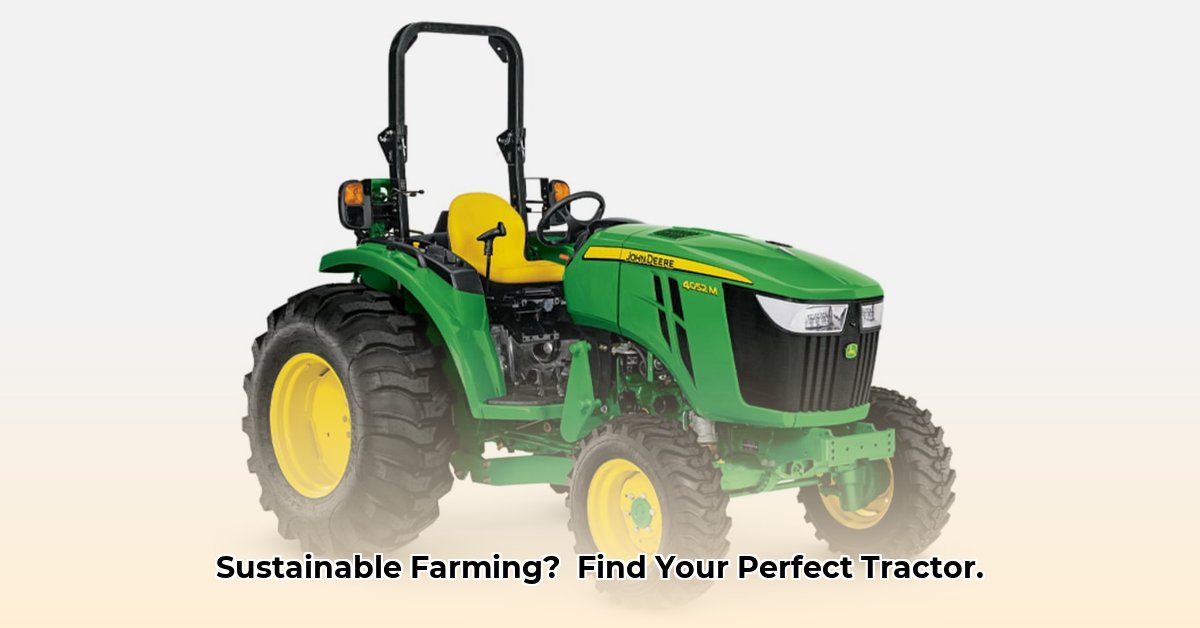
Choosing the right compact tractor is a significant investment for any sustainable farm. This guide helps you navigate the options, considering farm size, budget, and environmental impact to make an informed decision. We'll explore various tractor series, key features influencing sustainability, and the true cost of ownership, empowering you to select the perfect machine for your operation. For more on tractor types, see this helpful guide: tractor types.
Understanding Tractor Series: Power and Capability
Four-wheel drive compact tractors are categorized by horsepower and capability, much like choosing a vehicle for different tasks. The series generally reflects the tractor's size and power.
Sub-compact (1 & 2 Series): Ideal for smaller farms, hobby farms, or tasks requiring maneuverability in tight spaces. These tractors typically offer lower horsepower and fuel efficiency but are less expensive to purchase and maintain.
Mid-size (3 Series): A versatile option balancing power and maneuverability, suitable for a wider range of tasks on medium-sized farms. They offer a more substantial power output than sub-compacts.
Larger (4 Series): Workhorses suited for large farms and heavy-duty applications. These offer higher horsepower but come with increased purchase price and fuel consumption.
Considering your farm's acreage and typical tasks is crucial in determining the appropriate tractor series. A small farm may only need a sub-compact, while a larger operation will benefit from a mid-size or larger model. Think about the scale and intensity of your work.
Key Features Impacting Sustainability
Several tractor features directly affect your farm's environmental footprint and operational efficiency. Let's examine crucial aspects:
Transmission Type: Hydrostatic vs. Gear
Hydrostatic: Offers smooth, precise control, ideal for delicate tasks and maneuverability. However, hydrostatic transmissions may be less fuel-efficient than gear transmissions, especially under consistent, heavy loads.
Gear: Generally provides better fuel efficiency for tasks requiring consistent power and speed, like plowing or tilling. However, they may lack the fine control of hydrostatic transmissions.
The best choice depends on your primary tasks. Do you need precise control, or consistent power at a steady speed? This choice directly impacts fuel consumption and thus, sustainability.
Engine Type and Fuel Efficiency
Fuel efficiency is paramount. While manufacturers provide estimates, real-world consumption varies with terrain, conditions, and operator technique. Diesel engines are often more fuel-efficient than gasoline for agricultural tasks, but model-specific consumption rates should be researched carefully. Consider consulting with other farmers using similar tractors in your region to gauge real-world fuel usage. It is a significant component of the overall lifecycle costs.
Optional Attachments: Optimization and Efficiency
Attachments significantly influence productivity and fuel efficiency. A less energy-intensive mower will consume less fuel than a heavier, less optimized model. Choose attachments wisely, assessing their power requirements and suitability for your operations. Optimizing this aspect is vital for maximizing productivity and minimizing your environmental impact.
Cab Options and Climate Control: Operator Well-being and Efficiency
Modern cabs with climate control reduce operator fatigue. This translates to increased productivity and potentially longer working hours without compromising operator comfort and safety. A well-rested operator is a more efficient and productive operator. This benefit is often undervalued but is a key element in overall farm efficiency.
Technology Integration: Precision Agriculture for Reduced Waste
GPS guidance, auto-steering, and precision seeders minimize overlaps, reducing fuel and input waste (fertilizer, pesticides). While this represents an upfront investment, the long-term savings in resources and higher efficiency make it a strong argument for sustainability. These precision tools are increasingly important for modern, efficient, and environmentally responsible farming.
Materials and Manufacturing: Long-term Environmental Considerations
While limited data is publicly available, inquire about manufacturers' sustainability initiatives. Eco-friendly materials and responsible manufacturing processes reflect a conscientious approach to environmental stewardship. This is an area where more transparency from manufacturers is needed, and it's essential to ask specific questions.
Cost of Ownership Analysis: A Holistic Approach
The total cost goes beyond the sticker price. Consider these key factors:
Purchase Price: The initial investment.
Maintenance Costs: Regular maintenance prevents larger, more costly repairs, prolonging the tractor's lifespan. Factor in routine servicing and potential repairs.
Fuel Costs: Real-world fuel consumption, as discussed above, is a significant ongoing expense.
Tractor Lifespan: Opt for reliable models with a proven track record of longevity. A longer lifespan translates to lower annualized costs.
Resale Value: Consider the resale value; a well-maintained tractor retains more value.
Calculating your return on investment (ROI) is crucial to justify the purchase. Carefully estimate operating costs and compare them against the increased productivity and efficiency the tractor offers. This clarifies the financial implications of sustainably-minded choices.
Choosing the Right Tractor: A Step-by-Step Guide
Assess Farm Size and Tasks: Determine your farm's size and the specific tasks the tractor will perform to determine the necessary horsepower.
Establish a Budget: Include all foreseeable costs: purchase price, maintenance, fuel, and repairs.
Prioritize Features: Carefully weigh the importance of transmission type, fuel efficiency, technology, and comfort. Your priorities should reflect your operational needs and sustainability goals.
Compare Models and Research Reviews: Gather information from multiple sources, including manufacturer data, independent reviews, and discussions among farmers.
Test Drive (If Possible): A test drive provides invaluable insight into the tractor's handling and suitability for your specific tasks.
This process ensures a well-informed decision aligning your tractor choice with both your farm's needs and your commitment to sustainable practices.
Sustainability Beyond the Tractor
Sustainable farming extends beyond the equipment. Prioritize efficient fuel use, maintain your tractor diligently, and responsibly dispose of worn-out parts. These practices minimize your farm's environmental footprint and contribute to long-term operational cost savings.
In conclusion, selecting the right 4-wheel drive compact tractor requires careful consideration of several factors. Combining a comprehensive understanding of tractor capabilities, key features influencing sustainability, and a holistic cost analysis empowers you to make a truly informed decision, ensuring both the success and sustainability of your farming operation.